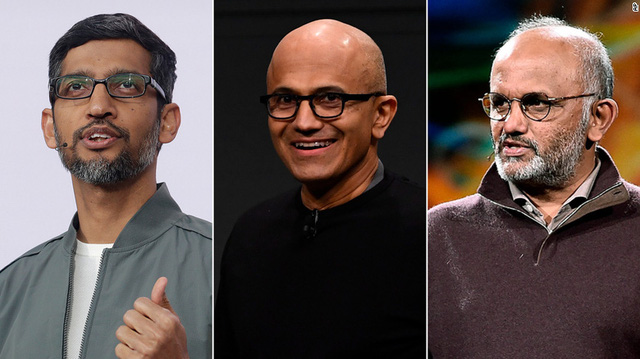What is the reason for the world’s largest corporations to hire Indian CEOs?
- Tram Ho
The following article shows the personal views of Mitra Kalita – Senior Vice President in charge of News, Perspectives and Informatics at CNN Digital. The Indian leader is also the author of two books on migration to the US and globalization.

IBM recently chose Arvind Krishna as the next CEO; Shortly thereafter, WeWork also appointed Sandeep Mathrani as chief executive. According to the media, more and more Indian CEOs are present in large corporations around the world. Google technology giant is not outside this ‘phenomenon’.
Here are some examples that I know of:
Shantanu Narayen, President and CEO of Adobe Sundar Pichai, Director of Alphabet Corporation
Satya Narayana Nadella, Microsoft Director
Rajeev Suri, Nokia Director
Vasant Vas Narasimhan, Director of Novartis
Ajaypal Ajay Singh Banga, Director of Mastercard
Niraj Shah, Director of Wayfair
Sanjay Mehrotra, Director of Micron
George Kurian, Director of NetApp
Nikesh Arora, Director of Palo Alto Networks
Dinesh C. Paliwal, Director of Harman International Industries
There are many more on this list that I cannot tell. Whether growing up in India or immigrating to the United States, they all enjoy many habits and experiences from previous generations.
This article does not claim that Indians are better or more successful than other nations. Contrary to that, I think external factors have contributed to the ‘trend’ of businesses hiring Indian CEOs. This speaks to the state of the US workplace – a global working environment with technological breakthroughs, where the best leaders are gathered.

Sundar Pichai, Google CEO since 2015. He also assumed the position of CEO Alphabet (Google’s parent company) in April 2019. Photo: Business Today
Here are 9 factors that I think we can all learn from Indian CEOs:
1. Accept the incident
Every business has to face the incident at some point. Take a look at the current India, a billion-people country with dozens of heterogeneous languages and infrastructure. People here face events in their daily lives, even if they have water to brush their teeth every morning. But they persevere, accepting anything beyond their control. This gives Indians the ability to adapt and be patient with the company’s existence.
2. Observe anytime anywhere
The ability to predict what makes a market an essential skill of a leader. The Indians always unconsciously observe, capture information and make plan B (that’s when we don’t have water to brush our teeth.)
WeWork CEO Mathrani, a veteran of the real estate industry, commented on the future of US trade centers as follows: ” You sit there and think: OK, if there are 1,100 centers in the country, Where is the future of this industry? “, he interviewed with CNBC. ” If that number is 800, how many percent do you want to own? I see good shopping centers will still grow and lesser competitors will disappear .”
The statement is nothing new but points to the bottom line: The best strategy for businesses to survive is when they know how to combine data with market conditions.
3. It’s all about proportions and figures
This does not indicate that Indians are good at math (my math scores have never been higher than 6). Think of it this way: ” When you grow up in a country of 1 billion people, everything is proportional; from matriculation to college; your rank in class; your class compared to with another class; the public servant recruitment exam; ‘win the lottery’ for a visa to go abroad . ” I always admired my cousins when I was young, because they always excelled at everything in order to create our best competitive opportunity.
With ‘ data intelligence ‘, a person can gain an important position in the leadership class without mentioning the skills required in modern CEOs. Coincidentally, at least three of the people on the list I mentioned (Pichai, Arora and Krishna) are graduates of the prestigious Indian Institute of Technology, among less than 2%.

From the left, Sundar Pichai (Alphabet), Satya Narayana Nadella (Microsoft) and Shantanu Narayen (Adobe). Photo: AP
4. Education, especially STEM (Science, Technology, Engineering, Mathematics)
The PEW Research Center says Indian immigrants are among the highest educated in the United States; 77.5% had a bachelor’s degree or higher in 2016 – the highest rate of any country here – compared to 31.6% of Native Americans. Over the past few decades, foreign students have filled vacancies in computer science and engineering in the United States. The skills in this industry are sought by companies, not just Big Tech (Apple, Microsoft, Facebook, Alphabet and Amazon).
5. Family work culture and ‘helicopter parents’
‘ Helicopter parents ‘ refers to parents who are always overly concerned, interfering with their children’s lives. When Indra Nooyi took over as CEO at PepsiCo, many people visited her mother in India to celebrate. Thanks to this, she came up with the idea to send the thank you card to the parents of the outstanding employees in PepsiCo. The former CEO shared: ” I am the result of my own education and realize that I have never thanked my colleagues’ parents for the good things their children have done for the company .”
Millennial parents have a great influence on their children’s careers. For example, Indian companies have a culture of family and work integration, they welcome colleagues to attend their sister’s wedding, blurring the lines between family and work before this becomes a trend. in Western countries.
6. Diversity
Diversity in the workforce and business leadership are becoming more important than ever. The Deloitte survey (also run by Indians) found that 69% of employees believed that the working environment would be more interesting under diverse leadership than 43% had the opposite opinion.
The CEOs on this list are considered to be the exception compared to what you often see in the workplace. Several studies show that Asians are very competent in technology companies, but they are rarely on the leadership list. Recent studies by technology companies indicate a higher success rate for Asian Americans than white Americans. This partly opens up opportunities for ending discrimination, remuneration and fair compensation.
The majority of Indians could move to the United States thanks to the Immigration and Nationality Act of 1965, created when the Civil Rights movement arose, in order to eliminate quotas and apartheid. As the Indians climbed the career ladder, they contributed to the representation of ethnic minorities in the United States.
7. Calculation of ‘original’
We are in an era of high authenticity, due to the emergence of social networks like Twitter as well as people who are more interested in the value, nature of a leader than an attractive personality.
Nooyi recalls reconciling indigenous roots as a leader in America. She recalled going to America in 1978 with nostalgia for her home cricket and replacing it with baseball, more specifically the Yankee team. ” I found out that business language is also a sport,” she said in an interview, “people in business analyze the game and if we are not part of the process, we feel that So I combined my love for cricket with the Yankees when I arrived here . ”
8. Time is precious and infinite
When I moved to India in 2006, I discovered the concept of time synchronization and how to apply it at work. Americans often see time in a sequential way, black and white, life and work. Another notion of time recognition is: ” The way we observe time passes; is a sequence of events happening consecutively or simultaneously. Does the past, the present and the future have something to do with each other ?” ”
Satya Nadella, CEO of Microsoft, has a similar view of the time, he shared in an interview with the Australian Financial Review : ” What I really care about and try to do is to reconcile personal and public interests. I see Microsoft as a platform to pursue my passion. To me, there’s no better way to relax . ”
9. Appreciate talent
Few would have expected that an American immigrant would become the CEO of a Fortune 500 company. This is said to be the philosophy of the American way of doing things. Simply put, it is an unbelievable story and also the principle of American capitalism that is always trusted by the market, investors, employees. It is this CEO who accepts and affirms. ” I am honored to be given so many good opportunities and so much luck ,” he told the non-profit human rights group. ” So the American dream is not a fairy tale .”
Indeed, and perhaps Indian CEOs have made them a reality.
Source : Genk
